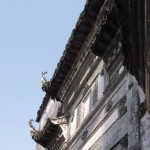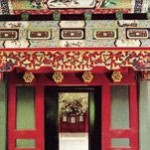View of Chinese vernacular dwelling-1
 In the year 2000, Xidi and Hongcun, the ancient villages in Anhui Province of China were formally approved on the 24th session of UNESCO’s World Heritage Committee to be inscribed into UNESCO’s World Heritage List. In early spring of that year, the Japanese Expert Dr. Naomi Okawa, assigned by UNESCO’s World Heritage Committee, highly valued the villages after his field investigation by saying that “it’s really an unrivalled village scene such as Hongcun”. “The village Xidi still remains its beautiful ancient streets and alleys, which is seldom in the world”. In 1997, old town of Li Jiang in Yunnan Province and ancient city of Pingyao in Shanxi Province were inscribed into the World Heritage List; nowadays,the famous river town Zhouzhuang in Jiangsu Province is on application for the list. At the turn of the century, the Chinese traditional vernacular dwelling is unveiling itself to the world, becoming a big stage for China’s access to the world and for the world to have a better understanding of China.
In the year 2000, Xidi and Hongcun, the ancient villages in Anhui Province of China were formally approved on the 24th session of UNESCO’s World Heritage Committee to be inscribed into UNESCO’s World Heritage List. In early spring of that year, the Japanese Expert Dr. Naomi Okawa, assigned by UNESCO’s World Heritage Committee, highly valued the villages after his field investigation by saying that “it’s really an unrivalled village scene such as Hongcun”. “The village Xidi still remains its beautiful ancient streets and alleys, which is seldom in the world”. In 1997, old town of Li Jiang in Yunnan Province and ancient city of Pingyao in Shanxi Province were inscribed into the World Heritage List; nowadays,the famous river town Zhouzhuang in Jiangsu Province is on application for the list. At the turn of the century, the Chinese traditional vernacular dwelling is unveiling itself to the world, becoming a big stage for China’s access to the world and for the world to have a better understanding of China.
China is a country with vast territory, varied topography and diversified climate, together with its different kinds of nationalities and cultures, which creates a rich variety of settlements and buildings of traditional vernacular dwelling. The residential houses can generally be divided into three partners: courtyard, storied and caved (or clay dwelling built with clay materials) dwellings.
Courtyard dwelling is the most popular vernacular dwelling among all the pa????erns and it is also the one with most advanced material and structure technology, the richest component, most complicated arrangements of traditional ethic code and diversified decorations.
In a sense, it is the most advanced dwelling style in the farming society and also the ideal mode to materialize the natural environment in the feudal society. The quadrangles in Beijing are the typical one of this pattern. The fundamental character of the courtyard dwelling is: being enclosed, symmetrical in middle axis and clear distinction between primary and secondary, outside and inside. Such kind of dwelling is mainly seen in North China, Central Plains, Shandong Peninsula, plains and coastal areas in South China. It also can be found in some basins and plains of the southwest of China and in the areas of Chengdu in Sichuan Province, Kunming and Dali in Yunnan Province and plain areas of Taiwan Island, etc. The courtyard dwelling is popularly adopted in many areas including the areas where the Hans se????le in, ethnic minority areas in close exchange with Han culture (such as the Bai and Nahsi nationalities) and some developed areas (such as Zhuang and Yi nationalities), or the ethnic minorities living with the Han nationality (such as Manchu and Hui nationalities). In marching into one of the international metropolises, laws have also been formulated in Be?ing to protect its 25 lanes and quadrangles in the ancient areas, ranging from Prince Gong’s Residential to common houses, which still have kept the most completed and almost whole forms of quadrangles of the courtyard dwelling. For example, as to the gate,  there are Naizi Fang Gate, Jinzhu Gate, Brilliant Gate, Ruyi Gate, Manzi Gate and so on, which make up the real museum of the quadrangle. Businessmen in Shanxi Province were in the leading position in building private residential in the period of the Ming and Qing dynasties. The Quadrangle Group of the Wang family in Lingshi County, known as the First House of Shanxi Province, is composed of over one hundred courtyards.
there are Naizi Fang Gate, Jinzhu Gate, Brilliant Gate, Ruyi Gate, Manzi Gate and so on, which make up the real museum of the quadrangle. Businessmen in Shanxi Province were in the leading position in building private residential in the period of the Ming and Qing dynasties. The Quadrangle Group of the Wang family in Lingshi County, known as the First House of Shanxi Province, is composed of over one hundred courtyards.
Despite of variation in scale, composition, decoration and other aspects, all the quadrangles, which are most popular in the northern plain areas, have the common fundamental characteristics, such as the famous Confucian Residence in Qufu (Shandong Province), Zheng Banqiao’s Former Residence in Weifang (Shandong Province) and the numerous old-style banking houses in the ancient city of Pingyao in Shanxi Province, etc.
The dwellings in the vast countryside are not as complete as the typical quadrangle; some dwellings only have three or two houses around a courtyard, such as the Manchu’s sun-facing rural dwelling in Liaoning and Jilin Provinces, Tu Wei Zi in Shaanxi and Shanxi Provinces, all of which are of simplified courtyard-dwelling categories remaining the basic structure of gate, wall, courtyard and central room and wing-room. There are many variation forms of such a courtyard dwelling as follows: the residential dwelling called Yi Ke Yin in Kunming, Yunnan Province, which generated from the cave uncalcined clay dwelling; Huizhou’s courtyard residential dwelling (In Chinese traditional architecture, the courtyard enclosed by the houses and walls was called tianjing in Chinese) in Anhui Province, which came from the ganlan (In ancient times, this kind of architectural mode with wood as main building materials was popular in southern China) wood dwelling combined with courtyard ; and the Yongding’s Hakka residential dwelling in Fujian Province, which was mainly built for self-defense under the specific historic and geographical circumstances; Da Cuo – a courtyard dwelling composed of red-brick wall, sloping roof and arc fireproof wall, made by immigrants from Guangdong and Fujian to Taibei area of Taiwan, and so on.
The earliest form of the courtyard dwelling emerged firstly in the period of  Qin and Han dynasties, and the figure bricks in the Eastern Han Dynasty give us a complete form of the then courtyard dwelling. The widespread of such a dwelling culture was due to the technological supports of Qin’s bricks and Han’s tiles, the improvement of feudal farming family pattern and the popularization of etiquette norms. And in the long period of time of farming society, this vernacular dwelling pattern showed its extremely strong vitality.
Qin and Han dynasties, and the figure bricks in the Eastern Han Dynasty give us a complete form of the then courtyard dwelling. The widespread of such a dwelling culture was due to the technological supports of Qin’s bricks and Han’s tiles, the improvement of feudal farming family pattern and the popularization of etiquette norms. And in the long period of time of farming society, this vernacular dwelling pattern showed its extremely strong vitality.